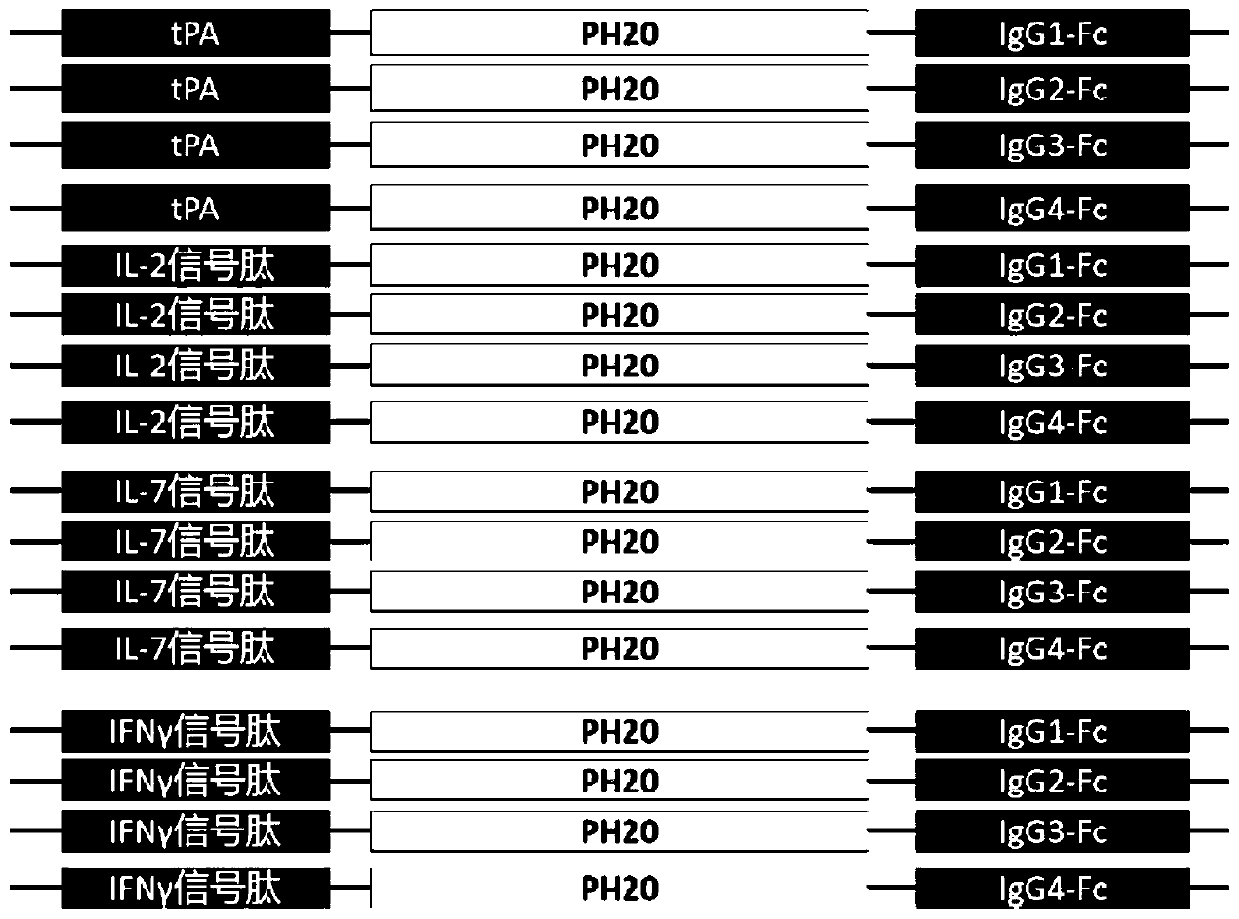Immune cell expressing hyaluronidase and application thereof
A technology of hyaluronidase and immune cells, applied in the field of immune cells and its application in anti-tumor therapy, can solve the problem that the anti-tumor function of immune cells cannot be fully exerted, cannot specifically degrade hyaluronic acid, and cannot exert infiltration To achieve good tumor infiltration ability, enhance anti-tumor activity, and improve transduction efficiency
- Summary
- Abstract
- Description
- Claims
- Application Information
AI Technical Summary
Problems solved by technology
Method used
Image
Examples
Embodiment 1
[0062] Construction of Hyaluronidase Overexpression Plasmid
[0063] Such as figure 1 As shown, the hyaluronidase overexpression gene includes a signal peptide, a hyaluronidase catalytic activity sequence and a stable sequence, and the construction steps include:
[0064] (1) Obtain the DNA of each region required by the PH20 overexpression plasmid through gene synthesis, including: signal peptide, PH20 hyaluronidase catalytic activity region and stable sequence, and the fusion gene constructed is as follows: Figure 2A-Figure 2C As shown, wherein the signal peptide includes tPA signal peptide, IL-2 signal peptide, IL-7 signal peptide, IFNγ signal peptide, PH20 original signal peptide, GMCSF signal peptide, IL-6 signal peptide or IL-15 signal peptide; stable The sequence includes a human IgG1 Fc region sequence, a human IgG2 Fc region sequence, a human IgG3 Fc region sequence or a human IgG4 Fc region, and the amino acid sequence of the constructed fusion gene is shown in SEQ...
Embodiment 2
[0082] PH20 overexpression vector lentiviral packaging
[0083] (1) Cultivate 293T cells in a 10cm culture dish, the culture medium is: DMEM high glucose medium + 10% FBS (fetal bovine serum) + 1% double antibody (100 × penicillin-streptomycin mixed solution);
[0084] (2) When the 293T cell density in the culture dish reaches 80%, replace the medium: DMEM high glucose medium + 1% FBS + 1% double antibody;
[0085] (3) After replacing the culture medium for 2 hours, start step (4);
[0086] (4) Take 500 μL of opti-DMEM into a 15 mL centrifuge tube, and add 7.2 μL of PEI (linear polyethyleneimine) with a concentration of 10 μg / μL, mix slightly, and let stand for 5 minutes;
[0087] (5) Put 500 μL of opti-DMEM into a 15 mL centrifuge tube, take 9 μg of the target plasmid, 3 μg of the pMD2.G helper plasmid, and 12 μg of psPAX, add it to the centrifuge tube, and mix well;
[0088] (6) After step (4) is completed, mix the solution of step (5) with it, mix it upside down, and let ...
Embodiment 3
[0095] PH20 Gene Overexpression Lentivirus Transduced T Cells
[0096] (1) T cell activation: After sorting out PanT from umbilical cord blood, count the cells and adjust the concentration to 1×10 6 cells / mL, then add 10 μL of Miltenyi TransAct T cell reagent to each ml of cell suspension, and replace with fresh medium after 48 hours of activation (medium: IMDM medium + 5% FBS (fetal bovine serum) + 1% Double antibody (100×penicillin-streptomycin mixed solution)+IL-2);
[0097] (2) Convert 4.8×10 7 The activated T cells were centrifuged at 300g for 5min, and resuspended with 3mL medium (medium: IMDM medium + 5% FBS (fetal bovine serum) + 1% double antibody (100×penicillin-streptomycin mixed solution)) ;
[0098] (3) Inoculate 3 mL of T cell suspension in a 6-well plate, 1 mL per well;
[0099] (4) Add the packaged PH20 gene overexpression lentiviral vector to a 6-well plate, 9 mL per well;
[0100] (5) Add 10 μL polybreen to each well;
[0101] (6) After culturing for 8 ...
PUM
 Login to View More
Login to View More Abstract
Description
Claims
Application Information
 Login to View More
Login to View More - R&D
- Intellectual Property
- Life Sciences
- Materials
- Tech Scout
- Unparalleled Data Quality
- Higher Quality Content
- 60% Fewer Hallucinations
Browse by: Latest US Patents, China's latest patents, Technical Efficacy Thesaurus, Application Domain, Technology Topic, Popular Technical Reports.
© 2025 PatSnap. All rights reserved.Legal|Privacy policy|Modern Slavery Act Transparency Statement|Sitemap|About US| Contact US: help@patsnap.com



